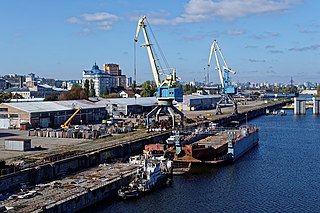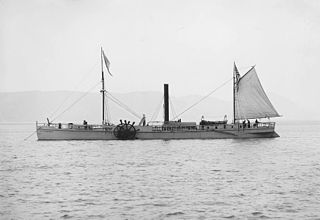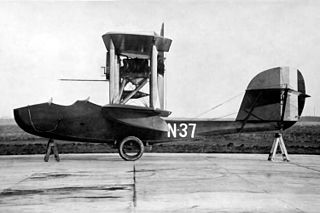
A paddle steamer is a steamship or steamboat powered by a steam engine driving paddle wheels to propel the craft through the water. In antiquity, paddle wheelers followed the development of poles, oars and sails, whereby the first uses were wheelers driven by animals or humans.

Panamax and New Panamax are terms for the size limits for ships travelling through the Panama Canal. The limits and requirements are published by the Panama Canal Authority (ACP) in a publication titled "Vessel Requirements". These requirements also describe topics like exceptional dry seasonal limits, propulsion, communications, and detailed ship design.

The Yakovlev Yak-24 is a Soviet twin-engine, tandem rotor, transport helicopter developed by Yakovlev in the 1950s. The Yak-24 saw limited use in the Soviet Air Force, and the exact number produced and duration of service are unknown due to inconsistencies in data.

The Sovetsky Soyuz-class battleships, also known as "Stalin's Republics", were a class of battleships begun by the Soviet Union in the late 1930s but never brought into service. They were designed in response to the Bismarck-class battleships being built by Germany. Only four hulls of the fifteen originally planned had been laid down by 1940, when the decision was made to cut the program to only three ships to divert resources to an expanded army rearmament program.

The Kyiv River Port is the main river port of Kyiv, located on the right bank of the Dnieper River in the Podil neighborhood of the city. The port has an own fleet that serves as a shipping company. It also has departments in Pereiaslav and Rzhyshchiv.

The North River Steamboat or North River, colloquially known as the Clermont, is widely regarded as the world's first vessel to demonstrate the viability of using steam propulsion for commercial water transportation. Built in 1807, the North River Steamboat operated on the Hudson River – at that time often known as the North River – between New York City and Albany, New York. It was built by the wealthy investor and politician Robert Livingston and inventor and entrepreneur Robert Fulton (1765–1815).

The Avro 534 Baby was a British single-seat light sporting biplane built shortly after the First World War.
German submarine U-380 was a Type VIIC U-boat built for Nazi Germany's Kriegsmarine for service during World War II. Her wartime career consisted of 11 patrols and resulted in two ships sunk for 14,063 GRT, one ship damaged, and another of 7,178 GRT that was later declared a total loss.
The Beardmore W.B.IV was a British single-engine biplane ship-based fighter of World War I developed by Beardmore. Only one was built.

The Douglas DF was a commercial flying boat built by Douglas Aircraft Company, first flown on 24 September 1936.
The Aichi AB-4 was a Japanese flying boat of the 1930s. A single engined biplane, the AB-4 was intended to carry out night reconnaissance for the Imperial Japanese Navy. Six were built and accepted into service as the Experimental 6-Shi Night Reconnaissance Flying boat, three of which were converted to civil transports.

The Norman Thompson N.1B was a prototype British flying boat fighter aircraft of the First World War. A two-seat single-engined pusher biplane, a single example was built in 1917, but no production followed.

German submarine U-751 was a Type VIIC U-boat built for Nazi Germany's Kriegsmarine for service during World War II. Built as yard number 134 of the Kriegsmarinewerft shipyard in Wilhelmshaven, she was commissioned on 31 January 1941. She served with 7th U-boat Flotilla until 1 June as a training boat, and as an operational boat until 17 July 1942, under the command of Kapitänleutnant Gerhard Bigalk. U-751 served in seven patrols with the 7th U-boat Flotilla, sinking the escort carrier HMS Audacity. The U-boat was attacked with depth charges from aircraft on 17 July 1942 and sank with the loss of all 48 crew members.
The Adolphe Bernard AB was a twin-engined French biplane aircraft, built near the end of the First World War. Ten AB 1 BN2 bombers were produced for the Armée de l'Air but did not reach squadron service; post-war, two civil derivatives were considered but only one aircraft was built.

Bulgaria was a class 785/OL800 Russian river cruise ship which operated in the Volga-Don basin. On 10 July 2011, Bulgaria sank in the Kuybyshev Reservoir of the Volga River near Syukeyevo, Kamsko-Ustyinsky District, Tatarstan, Russia, with 201 passengers and crew aboard when sailing from the town of Bolgar to the regional capital, Kazan. The catastrophe led to 122 confirmed deaths.

The Type V ship is a United States Maritime Commission (MARCOM) designation for World War II tugboats. Type V was used in World War II, Korean War, and the Vietnam War. Type V ships were used to move ships and barges. Type V tugboats were made of either steel or wood hulls. There were four types of tugboats ordered for World War II. The largest type V design was the sea worthy 186-foot (57 m) long steel hull, V4-M-A1. The V4-M-A1 design was used by a number of manufacturers; a total of 49 were built. A smaller steel hull tugboat was the 94-foot (29 m) V2-ME-A1; 26 were built. The largest wooden hull was the 148-foot (45 m) V3-S-AH2, of which 14 were built. The smaller wooden hull was the 58-foot (18 m) V2-M-AL1, which 35 were built. Most V2-M-AL1 tugboats were sent to the United Kingdom for the war efforts under the lend-lease act. The Type V tugs served across the globe during World War II including: Pacific War, European theatre, and in the United States. SS Farallon, and other Type V tugs, were used to help built Normandy ports, including Mulberry harbour, on D-Day, 6 June 1944, and made nine round trips to Normandy to deliver Phoenix breakwaters.
SS Lexington was an American Passenger ship that collided with Jane Christenson and sank on 2 January 1935 on the East River in New York City while carrying general cargo and 201 passengers and crew from New York to Providence, Rhode Island.

Stremitelny was one of 29 Gnevny-class destroyer built for the Soviet Navy during the late 1930s. Completed in 1938, the ship was assigned to the Baltic Fleet and played a minor role in the 1939–1940 Winter War against Finland. Stremitelny was transferred to the Northern Fleet in mid-1940. After the start of the German invasion of the Soviet Union in June 1941, she covered an amphibious landing along the Arctic coast. The ship was attacked and sunk by German dive bombers the following month in Polyarny with the loss of 111 crew and passengers. Her wreck was partially salvaged the following year.

Smetlivy was one of 29 Gnevny-class destroyers built for the Soviet Navy during the late 1930s. Completed in 1938, she was assigned to the Baltic Fleet and played a minor role in the 1939–1940 Winter War against Finland. After the start of the German invasion of the Soviet Union in June 1941, the ship participated in the Gulf of Riga Campaign before withdrawing to Tallinn, Estonia. Smetlivy supported Soviet forces during the defense of Tallinn in August and covered the subsequent evacuation to Leningrad. The ship provided naval gunfire support to the defenders of Leningrad over the next several months before she was assigned to evacuate Soviet troops from their enclave in Hanko, Finland, in November. Smetlivy struck several mines returning from Hanko and sank with heavy loss of life.

Hableány was a 27-metre (89 ft) river cruiser operated on the Danube river in Budapest, Hungary. On the rainy night of May 29, 2019, at 9:05 pm the 135-metre (443 ft) Viking Sigyn collided with Hableány from behind under the Margaret Bridge near the Parliament Building. Hableány sank in 7 seconds. The heavy rainfall and the resulting strong currents hampered rescue efforts, with some bodies found 100 km downstream. With 2 Hungarian crew and 33 South Korean tourists on board, 7 tourists were rescued at the scene; one person is still missing and all others were later found to be dead.

















